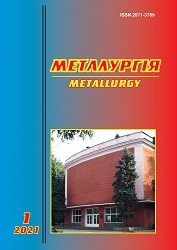DIFFERENTIAL ASSIMILATION COEFFICIENTS IN STEEL PRODUCTION CONTROL SYSTEMS
Abstract
Thermodynamic analysis of the «metal-slag» and «metal-slag-gas» systems using the Gibbs chemical potential method has been carried out. The concept of differential assimilation coefficients (DAC) is introduced, which take into account all the cross-effects of the influence of some chemical elements in the metal on the content of others. The definition of DAC as a change in the mass of the i-th element in the metal when adding a unit of mass of the j-th element to the system is given. Analytical expressions for DAC, which are necessary for effective solution of the inverse problem in control systems of melting and alloying processes of liquid steel, are obtained. Specific requirements to the components of the square matrix of DAC concerning its action on the valence vectors of chemical elements in the slag and the composition of the equilibrium metal and slag are formulated. A method for testing the used thermodynamic models of multicomponent solutions in metal and slag by analytical calculation of DAC is proposed. The concept of differential concentration matrix (DCM) as a derivative of DAC is introduced, the elements of which are equal to the change in the con-centration of the i-th element in the metal when adding the unit mass of the j-th element to the system. It is shown that DCM can be used to classify various ma-terials in respect to their effect on the content of oxygen, sulfur, phosphorus and other impurities in steel at the current state of the system «metal-slag-gas». Sys-tems of inequalities with matrices of DAC or DCM for optimization of materials quantities using simplex method on condition of guaranteed compliance in the set chemical composition of an intermediate product or grade structure of steel are derived. An analysis of the possible impact of technological and organizational constraints on the solution of the extended system of inequalities has been made. It is concluded that the use of DAC is a key feature and a necessary element of modern computer control systems for melting and out-of-furnace processing of steel. Examples of practical application of DAC in systems of design and control of steel production are given.
References
2. Храпко С.А., Иноземцева Е.Н., Харченко А.В. Термодинамическая модель системы металл-шлак-газ и интегрированная система «Оракул»: использование для прогнозных расчётов и управления в составе АСУТП и разработки сталеплавильных процессов. «Тезисы докладов конф. «Моделирование физико-химических систем и технологических процессов в металлургии». Новокузнецк : наука, 1991. С. 222–223.
3. Харченко А.В., Будаква С.А. Интегрированный расчет материального, энергетического и теплового балансов плавки в системах управления сталеплавильными процесами. Труды Девятого конгресса сталеплавильщиков. Старый Оскол, 17-19.10.2006. Моcква : Черметинформация, 2007. С. 178–187.
4. Харченко А.В., Пономаренко А.Г., Корзун Е.Л. Термодинамическая модель многокомпонентной конденсированной фазы. Металлургическая и горнорудная промышленность. 2004. № 8(228). С. 135–139.
5. Харченко А.В., Синяков Р.В. Термодинамическая модель многокомпонентной жидкой шлаковой фазы / А.В. Харченко. Металургiя : наукові праці ЗДІА. 2016. Вип. 2(36). С. 16–22.
6. Харченко А.В. Теплоёмкость и другие термодинамические функции смешения многокомпонентной конденсированной фазы. Металургiя : наукові праці ЗДІА. 2012. Вип. 2(27). С. 20–28.
7. Харченко А.В., Пономаренко А.Г. Термодинамическое моделирование системы металлшлак-газ с учетом тепла химических реакцій. Металлургическая и горнорудная промышленность. 2004. № 8. С. 40–43.
8. Харченко А.В. Термодинамическое моделирование системы «металл-шлак-газ» с учетом энтальпийного теплового баланса. Метал та лиття України. 2005. Том 13. № 6. С. 13–17.
9. Харченко А.В., Личконенко Н.В. Вторичное электротермическое легирование и рафинирование металла с участием газовой фазы. Металургiя : наукові праці ЗДІА. 2016. Вип. 1(35). С. 9–13.
10. Харченко А.В., Синяков Р.В., Личконенко Н.В. Применение метода химических потенциалов Гиббса в черной металлургии. Металургiя : наукові праці ЗДІА. 2017. Вип. 2(38). С. 20–25.
11. Синяков Р.В. Разработка технологии выплавки и внепечной обработки стали с использованием программного комплекса «DesigningMelt». Современная электрометаллургия. 2011. № 2. С. 34–37.
12. Синяков Р.В., Харченко А.В. Автоматизированное проектирование и управление кислородно-конвертерной плавкой. Металлургическая и горнорудная промышленность. 2018. № 3. С. 14–26.
13. Харченко, А.В., Ковалев В.Л., Личконенко Н.В., Ляшенко Р.П. Усовершенствование системы контроля сталеплавильного производства «Мастер». Металургiя : наукові праці ЗДІА. 2019. Вип. 2(42). С. 11–15.
14. Харченко А.В. Личконенко Н.В., Мосейко Ю.В. Возможности и перспективы использования программы «Excalibur» в учебном процессе. Металургiя : наукові праці ЗДІА. 2013. Вип. 1(29). С. 169–175.

 ISSN
ISSN 


